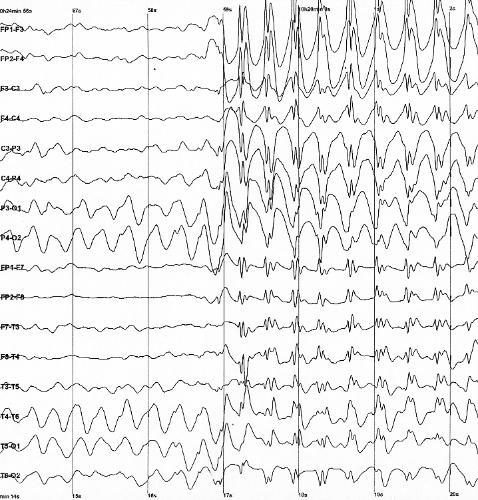Pediatric Epilepsy Syndromes 05
Topic: PediatricCreated on Thursday, October 4 2007 by jdmiles
Last modified on Thursday, October 4 2007.
An 8 year old girl presents to your office accompanied by her parents. The parents state that she has been having frequent staring spells. Past medical history is otherwise unremarkable. There is no family history of seizures. Exam is normal. You obtain an EEG, which shows the following finding:  Courtesy of Wikimedia Commons Of the following options, which agent is the best choice as a first-line monotherapy treatment?
This question was created on October 04, 2007 by jdmiles.
This question was last modified on October 04, 2007.
ANSWERS AND EXPLANATIONS
A) Felbamate
This answer is incorrect.
This child has childhood absence epilepsy. Felbamate may be effective in treating absence seizures, but has an increased risk for potentially fatal hepatotoxicity, and is therefore not the initial treatment of choice. ( See References)
|
 |  |  | 
|  |  | | Please log in if you want to rate questions. |
B) Carbamazepine
This answer is incorrect.
This child has childhood absence epilepsy. Carbamazepine is ineffective in the treatment of absence seizures, and may exacerbate absence seizures in some patients. Carbamazepine is effective as monotherapy or in combination with other agents for the treatment of partial seizures (particularly complex partial seizures), and generalized tonic-clonic seizures. ( See References)
|
 |  |  | 
|  |  | | Please log in if you want to rate questions. |
C) Clonazepam
This answer is incorrect.
This child has childhood absence epilepsy. Clonazepam is frequently used as adjunctive therapy if ethosuximide or valproate fail to control seizures. However, it is not the recommended first-line treatment. ( See References)
|
 |  |  | 
|  |  | | Please log in if you want to rate questions. |
D) Valproate
This answer is correct.
This child has childhood absence epilepsy. Ethosuximide is considered the initial treatment of choice if the patient has only absence seizures. If motor seizures are also observed, then valproate is the preferred agent. Lamotrigine is also a commonly-used monotherapy. ( See References)
|
 |  |  | 
|  |  | | Please log in if you want to rate questions. |
E) Phenytoin
This answer is incorrect.
This child has childhood absence epilepsy. Phenytoin may be ineffective in absence seizures, and is not a recommended first-line agent. ( See References)
|
 |  |  | 
|  |  | | Please log in if you want to rate questions. |
References:
| 1. Levin, K.H., and Luders, H.O. (Eds.) (2000). Comprehensive Clinical Neurophysiology. W.B. Saunders Company, Philadelphia.
| |
| 2. Trescher, W.H., and Lesser, R.P. (2004). The epilepsies. In Bradley, W.G., Daroff, R.B., Fenichel, G.M., and Jankovic, J. (Eds.). Neurology in Clinical Practice, Fourth Edition. Butterworth Heinemann, Philadelphia, pp. 1953-1992.
| |
| 3. edited by Richard T. Johnson, John W. Griffin and Justin C. McArthur. . St. Louis, Mo. : Mosby, 2001. (ISBN:0323014720)
| Advertising:
|
| 4. Wheless, J.W., Clarke, D.F., and Carpenter, D. (2005). "Treatment of pediatric epilepsy: expert opinion, 2005." J Child Neurol, 20 Suppl 1 S1-56; quiz S59-60. (PMID:16615562) |  |
| 5. Faught, E. (2003). "Clinical trials for treatment of primary generalized epilepsies." Epilepsia, 44 Suppl 7 44-50. (PMID:12919339) |  |
| 6. Murphy, ., and Delanty, . (2000). "Primary Generalized Epilepsies." Curr Treat Options Neurol, 2(6) 527-542. (PMID:11096777) |  |
|
 |  |  | 
|  |  | | Please log in if you want to rate questions. |
FrontalCortex.com -- Neurology Review Questions -- Neurology Boards -- Board Review -- Residency Inservice Training Exam -- RITE Exam Review
pediatric
Pediatric Epilepsy Syndromes 05
Question ID: 100307151
Question written by J. Douglas Miles, (C) 2006-2009, all rights reserved.
Created: 10/04/2007
Modified: 10/04/2007
Estimated Permutations: 25200
1 user entries
|
|

























